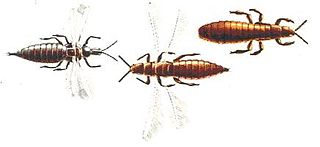
Thrips are minute, slender insects with fringed wings and unique asymmetrical mouthparts. Entomologists have described approximately 7,700 species. They fly only weakly and their feathery wings are unsuitable for conventional flight; instead, thrips exploit an unusual mechanism, clap and fling, to create lift using an unsteady circulation pattern with transient vortices near the wings.
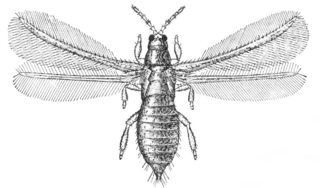
The Thripidae are the most speciose family of thrips, with over 290 genera representing just over two thousand species. They can be distinguished from other thrips by a saw-like ovipositor curving downwards, narrow wings with two veins, and antennae of six to ten antennomeres with stiletto-like forked sense cones on antennal segments III and IV.

The Aeolothripidae are a family of thrips. They are particularly common in the holarctic region, although several occur in the drier parts of the subtropics, including dozens in Australia. Adults and larvae are usually found in flowers, but they pupate on the ground. While they normally prey on other arthropods, many feed also on flowers.

Orthotospovirus is a genus of negative-strand RNA viruses, in the family Tospoviridae of the order Bunyavirales, which infects plants. Tospoviruses take their name from the species Tomato spotted wilt orthotospovirus (TSWV) which was discovered in Australia in 1919. TSWV remained the only known member of the family until the early 1990s when genetic characterisation of plant viruses became more common. There are now at least twenty species in the genus with more being discovered on a regular basis. Member viruses infect over eight hundred plant species from 82 different families.

The chilli thrips or yellow tea thrips, Scirtothrips dorsalis Hood, is an extremely successful invasive species of pest-thrips which has expanded rapidly from Asia over the last twenty years, and is gradually achieving a global distribution. It has most recently been reported in St. Vincent (2004) Florida (2005), Texas (2006), and Puerto Rico (2007). It is a pest of economic significance with a broad host range, with prominent pest reports on crops including pepper, eggplant, mango, citrus, strawberry, grapes, cotton, tea, peanuts, blueberry, and roses. Chilli thrips appear to feed preferentially on new growth, and infested plants usually develop characteristic wrinkled leaves, with distinctive brown scarring along the veins of leaves, the buds of flowers, and the calyx of fruit. Feeding damage can reduce the sale value of crops produced, and in sufficient numbers, kill plants already aggravated by environmental stress. This thrips has also been implicated in the transmission of three tospoviruses, but there is some controversy over its efficiency as a vector.

Paraneoptera or Acercaria is a superorder of insects which includes lice, thrips, and hemipterans, the true bugs. It also includes the extinct order Permopsocida, known from fossils dating from the Early Permian to the mid-Cretaceous.
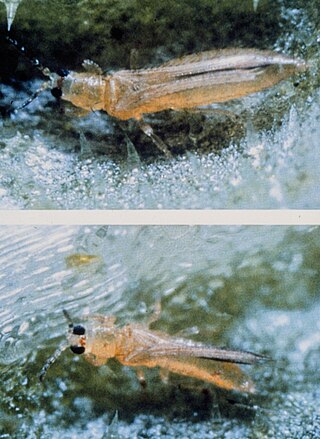
Thrips palmi is an insect from the genus Thrips in the order Thysanoptera. It is known commonly as the melon thrips.
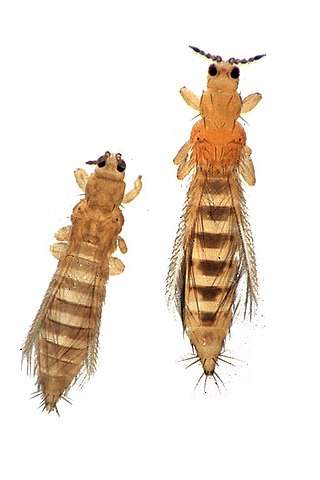
The Thripinae are a subfamily of thrips, insects of the order Thysanoptera. The Thripinae belong to the common thrips family Thripidae and include around 1,400 species in 150 genera. A 2012 molecular phylogeny found that the Thripinae was paraphyletic; further work will be needed to clarify the relationships within the group.

Thrips is a genus of insect in the order Thysanoptera.
Misthodotes is an extinct genus of mayflies which existed during the Permian of what is now the United States and Russia. It was described by E.H. Sellards in 1909. A new species, M. tshernovae, was described from the Upper Permian epoch of Russia by N. D. Sinitshenkova and D. V. Vassilenko in 2012.

Haplothrips is a genus of thrips in the family Phlaeothripidae. It is found worldwide and contains about 240 extant species.

The Protocoleoptera are a paraphyletic group of extinct beetles, containing the earliest and most primitive lineages of beetles. They represented the dominant group of beetles during the Permian, but were largely replaced by modern beetle groups during the following Triassic. Protocoleopterans typically possess prognathous (horizontal) heads, distinctive elytra with regular window punctures, culticles with tubercles or scales, as well as a primitive pattern of ventral sclerites, similar to the modern archostematan families Ommatidae and Cupedidae. They are thought to have been xylophagous and wood boring.
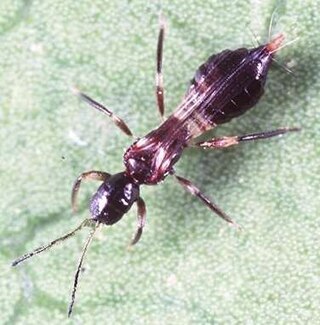
Terebrantia is a suborder of thrips. Order Thysanoptera includes 5,500 species classified into two suborders distinguished by the ovipositor. Terebrantia have a well-developed conical ovipositor, while the Tubulifera do not. It contains 13 families, five of which are only known from fossils. Members of Terebrantia mainly feed on plants. All have two larval instars followed by two pupal instars.
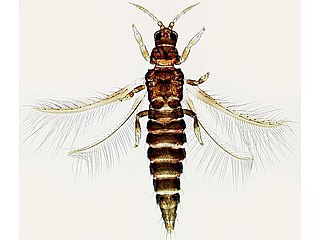
Echinothrips americanus is a species of thrips in the family Thripidae. It is found in North America, Europe, and Asia. E. americanus was first described in 1913 by entomologist A.C. Morgan in Quincy, Florida, where he found the insect on a Veratrum viride plant. Suggested common names include Poinsettia thrips and Impatiens thrips. Since their spread throughout Europe as early as 1995, and subsequently China, E. americanus has been called an "upcoming pest."
Merothripidae is a family of thrips in the order Thysanoptera. There are at least 4 genera and 20 described species in Merothripidae.
Heterothripidae is a family of thrips in the order Thysanoptera. There are about 6 genera and at least 70 described species in Heterothripidae.

Permopsocida is an extinct order of insects known from the Early Permian to the Mid-Cretaceous. It is part of Paraneoptera, alongside bark lice, bugs and thrips. Within Paraneoptera it is considered to be closer to the clade containing bugs and thrips rather than bark lice, with an estimated divergence during the Late Carboniferous. The group was first named as a suborder by Robert John Tillyard in 1926, and was raised to a full order by Huang et al. in 2016. It is currently divided up into three families, Psocidiidae which is known from the Permian to Liassic. Permopsocidae which is only known from the Permian, and Archipsyllidae, which is known from the Late Triassic to mid-Cretaceous (Cenomanian). While most members of the group are known from compression fossils, several members of Archipsyllidae are 3 dimensionally preserved in Burmese amber, which has helped clarify the morphology and phylogenetic position of the group. The morphology of the mouthparts suggests that they were capable of suction feeding and chewing, with preserved angiosperm pollen grains in the gut of Psocorrhyncha suggesting that at least some members of the group were pollenivorous.
Permothrips is an extinct genus of thrips from the Archescytinidae family that is notable for being one of the oldest records of thrips to date. The type species was described by A. V. Martynov in 1935 on the basis of PIN 2506/4, a single exoskeleton found in Sedy, Russia. It was probably a fungus feeding ancestor of the Mesozoic thrips.
Lophioneurida is an extinct order of Thysanoptera, dating from the Carboniferous to the Cretaceous. It is likely paraphyletic, with modern thrips having evolved from members of the group.












